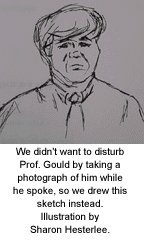Dispatch The Science and Celebrity of Baseball - Feb. 18, 2000
By Mary K. Miller
At the face of it, it seems only a matter of time for someone to better the slugger's record. After all, as humans we like the notion of patterns and progress. Why shouldn't baseball get better, within the limits of human physical performance, of course?
But as Gould points out, there's a paradox in this pattern. One of the highest achievements in batting is hitting 400. That statistic means that a batter safely hits the ball four hundred times for every one thousand at bats. Today's best hitters are around 300.
In the 1920s and 30s, seven players hit 400 or better, but since then only one slugger, Ted Williams in the 1941 season, has reached the pinnacle.
It could be argued, Gould says, that the reason batting records haven't surpassed 400 is that pitchers have gotten better. Batting averages are not separate entities, like a species. They're a measurement of batting against pitching.
If pitching is getting better relative to batting, the batting average should be going down and vice versa. But the average batting average has remained 260, circumstantial evidence that batting and pitching are progressing in lock step or not at all.
Gould believes that baseball players overall have improved while the rules of baseball have remained relatively constant (with some judicious rule changes). If you would plot the batting average vs number of batters of years ago, you will get a normal distribution (a bell shaped curve) with extremes at both ends. But it's the nature of systems and people to learn to do things better over time. Therefore the extremes - caused by bad pitching and/or bad batting - tend to diminish and the tails of the curves decrease. But the average tends to remain the same.
Early in baseball's history, the average play was relatively poor but, like modern athletics, a few good players rose above the rest. It's an American tradition to believe in the valor of the great, says Gould. The truly great can tweak the odds by virtue of their will and talent.
But today's great ones aren't just genetically or physically gifted; they also put forth tremendous effort, are intelligent and obsessed. McGwire himself has made an intense commitment to the science of home run hitting. For that reason, says Gould, McGwire is unlikely to be bested anytime soon.
(For more baseball science, see
The Science of Baseball
)
|
The museum of science, art, and human perception
©2000 The Exploratorium

 Stephen Jay Gould, current president of AAAS and a devoted baseball fan, was first at bat in this Friday morning session of the AAAS conference. The title of this talk-Breaking Mark McGwire's Record: Can Anyone Hit 71 Home Runs?
Stephen Jay Gould, current president of AAAS and a devoted baseball fan, was first at bat in this Friday morning session of the AAAS conference. The title of this talk-Breaking Mark McGwire's Record: Can Anyone Hit 71 Home Runs?